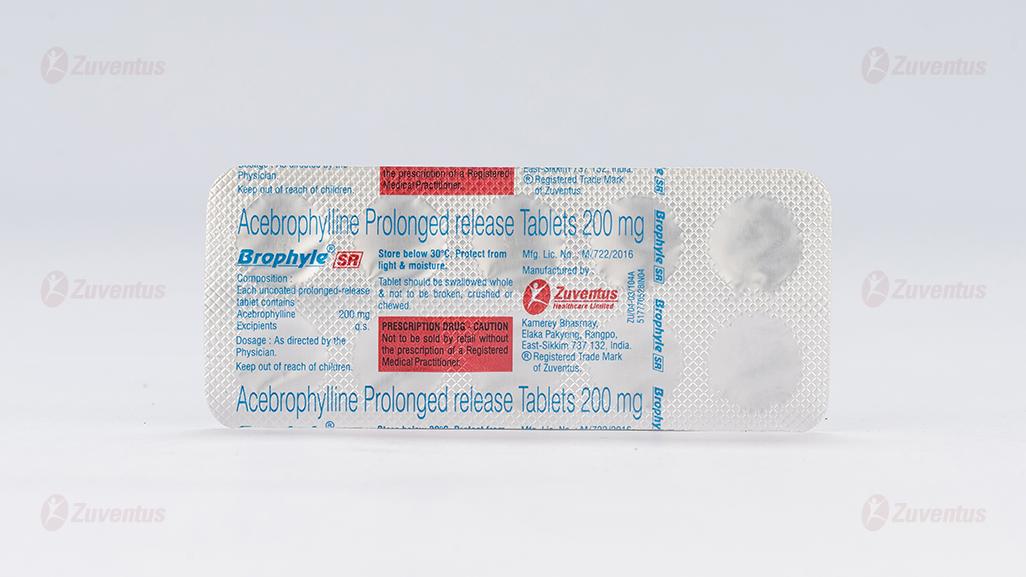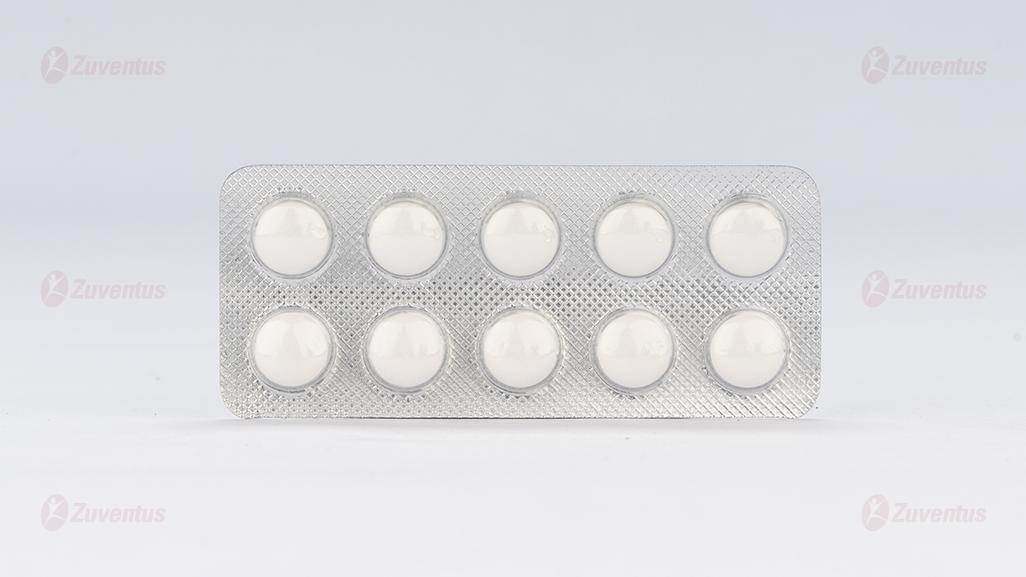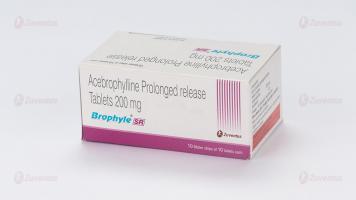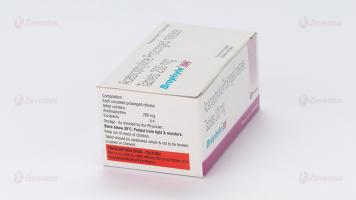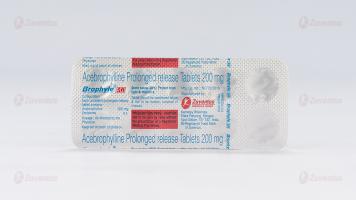Brophyle SR Tablets
Therapy Area
Respiratory
1.0 Generic name
Acebrophylline Prolonged release Tablets
2.0 Qualitative and quantitative composition
Each uncoated prolonged-release tablet contains:
Acebrophylline……………………………………. 200 mg
Excipients q.s.
3.0 Dosage form and strength
Tablet 200 mg
4.0 Clinical particulars
4.1 Therapeutic indication
For the treatment of adult patients with chronic obstructive pulmonary disease (COPD) and bronchial asthma.
4.2 Posology and method of administration
Adults
Acebrophylline is administered at a recommended dose of 1 tablet once daily.
4.3 Contraindications
Hypersensitivity to xanthine derivatives like theophylline or to ambroxol.
4.4 Special warnings and precautions for use
Acebrophylline should be administered with caution in patients with hypertension, heart diseases, peptic ulcers and severe hypoxemia.
4.5 Drugs interactions
Theophylline should not be administered concurrently with other xanthine preparations and caution is required due to the interaction between theophylline and ephedrine or other sympathomimetic bronchodilators. The concomitant administration of reserpine may result in tachycardia.
4.6 Use in special populations
Pregnancy & Lactation
Although there are no clinical studies in pregnant or lactating women, Acebrophylline should be avoided in these women, unless the benefits outweigh the risks.
4.7 Effects on ability to drive and use machines
Brophyle SR Tablet does not usually affect the ability to drive.
4.8 Undesirable effects
Commonly reported adverse effects with Acebrophylline include abdominal discomfort, stomach/abdominal distension, vomiting, abdominal pain, diarrhea, constipation, heart burn, loss of appetite, esophageal bleeding, rashes, urticaria, itching, drowsiness, difficulty in breathing, leukocytosis and nasal inflammation. If chills and fever occur the drug should be immediately discontinued.
Rarely occurring adverse events include headache, occasional numbness including numbness in arm, insomnia, tachycardia, fatigue, hypertension, albuminuria, glycosuria, hypotension and occasionally hyperglycemia.
Reporting of suspected adverse reactions
Reporting suspected adverse reactions after authorisation of the medicinal product is important. It allows continued monitoring of the benefit/risk balance of the medicinal product. Healthcare professionals are asked to report any suspected adverse reactions via email to: medico@zuventus.com
Website: https://www.zuventus.com/drug-safety-reporting
By reporting side effects, you can help provide more information on the safety of this medicine.
4.9 Overdose
In the event of overdose, the stomach may be emptied by gastric lavage within 2 hrs of overdose. Elimination may also be enhanced by repeated oral doses of activated charcoal. Treatment is symptomatic and supportive.
5.0 Pharmacological properties
5.1 Mechanism of Action / Pharmacodynamic Properties
Acebrophylline is an airway mucus regulator with anti-inflammatory actions. It has a multimodal mechanism of action involving effects on the pulmonary surfactant, bronchial secretions, phospholipase A and Phosphodiesterases. Theophylline-7-acetate, as with other xanthine derivatives, has a bronchodilator effect due to inhibition of the intracellular phosphodiesterases, followed by an increase of cyclic adenosine monophosphate levels, which promote the relaxation of bronchial muscles. Acebrophylline produces bronchodilation by specifically inhibiting phosphodiesterase III and IV.
Acebrophylline inhibits phospholipase A, and phosphatidylcholine leading to lesser production of the powerful pro-inflammatory substances like leukotrienes and tumour necrosis factor. By inhibiting the synthesis and release of these inflammatory mediators, Acebrophylline reduces inflammation, a key factor in airway obstruction, especially in chronic forms.
Acebrophylline increases the synthesis and secretion of pulmonary surfactants by acting on two levels of surfactant synthesis: the first involving ambroxol’s established action on phosphocholine-cytidyl-transferase and the second probably because of theophylline-7 acetic acid’s action on choline-kinase.
Ambroxol modifies the mucous gel phase of secretions by decreasing the viscosity and increasing the serous gel phase. It increases the mucociliary clearance by stimulating cilia motility. Thus, it has mucoregulatory, mucosecretory as well as mucokinetic actions, thereby normalizing the quantity & quality of pulmonary secretions.
5.2 Pharmacokinetic properties
On administration of 200 mg SR oral Acebrophylline, the two components of the molecule – ambroxol and theophylline-7-acetate are released in the stomach and absorbed in the intestines, reaching optimal concentrations of ambroxol and very low levels of theophylline- 7- acetic acid.
Thus it appears that the latter is either poorly absorbed or metabolized very fast and is eliminated in a fairly short time. Its low blood levels mean it is not likely to cause the untoward effects seen after theophylline, whose therapeutic window corresponds to much higher plasma concentrations (10-20 mcg/mL). Acebrophylline reaches its peak in serum (mean Cmax 136.458 +/- 7.079 ng/mL) at 1.708 +/- 0.550 hrs.
The elimination half-life of Acebrophylline is about 6.632 +/- 0.439 hrs. The drug is metabolized in the liver and eliminated renally.
6.0 Nonclinical properties
6.1 Animal Toxicology or Pharmacology
No known animal toxicology data
7.0 Description
Acebrophylline (Ambroxol theophylline-7-acetate) is the salt obtained by reaction of equimolar amounts of ambroxol, a drug showing mucolytic and expectorant properties, and theophylline-7-acetic acid, a xanthine derivative with specific bronchodilator activity.
Acebrophylline is obtained by targeted salification of the ambroxol base [trans-4(2-amino-3, 5 dibromobenzylamino)cyclohexanol] and theophylline 7 acetic acid. The carboxyl group of theophylline-7-acetic acid is salified with ambroxol’s amine group in a stoichiometric ratio (38.7% acid and 61.3% base) that ensures, after absorption, high plasma levels of ambroxol with low levels of the xanthine derivative which are nevertheless high enough to ensure a carrier effect for ambroxol. This means that one hour after administration lung levels of ambroxol are 45% higher than in subjects treated with ambroxol alone.
Its molecular formula is C22H28Br2N6O5 and its molecular weight is 616.3.
8.0 Pharmaceutical particulars
8.1 Incompatibilities
Not applicable
8.2 Shelf-life
Refer on pack
8.3 Storage and handing instructions
Store below 30°C. Protect from light & moisture.
Keep out of reach of children.
9.0 Patient counselling information
- You have been prescribed Brophyle SR Tablet for prevention and treatment of asthma and chronic obstructive pulmonary disease (COPD).
- It should be taken at the same time each day, preferably in the evening after food.
- It does not work right away and should not be used to relieve sudden breathing problems. Always keep a fast-acting (rescue) inhaler with you.
- Your doctor may take regular blood test to monitor potassium level and the level of this medicine in your body.
- Notify your doctor if you have ever been diagnosed with kidney, liver or heart disease, or if you have a smoking history. Your dose may need to be adjusted.
- Do not discontinue use without consulting your doctor, even if you feel better.
12.0 Date of revision
16.09.2022
About leaflet
Please read this leaflet carefully before you start using this medicine because it contains important information for you.
- Keep this leaflet. You may need to read it again.
- If you have any further questions, ask your doctor or pharmacist.
- This medicine has been prescribed for you. Do not pass it on to others. It may harm them, even if their signs of illness are the same as yours.
- If you get any side effects, talk to your doctor or pharmacist. This includes any possible side effects not listed in this leaflet.
What is in this leaflet
1. What Brophyle SR is and what it is used for
2. What you need to know before you use Brophyle SR
3. How to use Brophyle SR
4. Possible side effects
5. How to store Brophyle SR
6. Contents of the pack and other information
1. What Brophyle SR is and what it is used for
Brophyle SR contains the active substance acebrophylline, which is used to treat adult patients with chronic obstructive pulmonary disease (COPD) and bronchial asthma. It helps to reduce inflammation and relax the muscles in the airways, making it easier to breathe.
2. What you need to know before you use Brophyle SR
Do not take Brophyle SR if you:
- Are allergic to acebrophylline, theophylline, ambroxol, or any of the other ingredients of this medicine.
- Have a history of hypersensitivity to xanthine derivatives.
Warnings and precautions: Talk to your doctor or pharmacist before taking Brophyle SR if you:
- Have hypertension, heart diseases, peptic ulcers, or severe hypoxemia.
- Are pregnant or breastfeeding. This medicine should be avoided unless the benefits outweigh the risks.
Other medicines and Brophyle SR: Tell your doctor or pharmacist if you are taking, have recently taken, or might take any other medicines, especially:
- Other xanthine preparations
- Sympathomimetic bronchodilators (e.g., ephedrine)
- Reserpine
Important Precautions
- You have been prescribed Brophyle SR Tablet for prevention and treatment of asthma and chronic obstructive pulmonary disease (COPD).
- It should be taken at the same time each day, preferably in the evening after food. It does not work right away and should not be used to relieve sudden breathing problems. Always keep a fast-acting (rescue) inhaler with you.
- Your doctor may take regular blood test to monitor potassium level and the level of this medicine in your body.
- Notify your doctor if you have ever been diagnosed with kidney, liver or heart disease, or if you have a smoking history. Your dose may need to be adjusted.
- Do not discontinue use without consulting your doctor, even if you feel better.
3. How to take Brophyle SR
Always take this medicine exactly as your doctor or pharmacist has told you. Check with your doctor or pharmacist if you are not sure.
Adults:
- The recommended dose is one tablet once daily, preferably in the evening after food.
If you take more Brophyle SR than you should
Contact your doctor or go to the nearest hospital emergency department immediately. Symptoms of overdose may include nausea, vomiting, abdominal pain, and tachycardia.
If you forget to use Brophyle SR
If you forget to take at the right time, use it as soon as you remember, then carry on as before. Do not take a double dose to make up for a forgotten dose.
If you stop using Brophyle SR
Do not stop your treatment even if you feel better unless told to do so by your doctor.
Do not use in children.
If you have any further questions on the use of this medicine, ask your doctor, pharmacist or nurse.
4. Possible side effects
Like all medicines, this medicine can cause side effects, although not everybody gets them.
Common side effects:
- Abdominal discomfort, stomach distension, vomiting, abdominal pain, diarrhea, constipation, heartburn, loss of appetite, esophageal bleeding, rashes, urticaria, itching, drowsiness, difficulty in breathing, leukocytosis, nasal inflammation.
Rare side effects:
- Headache, numbness, insomnia, tachycardia, fatigue, hypertension, albuminuria, glycosuria, hypotension, hyperglycemia.
Reporting of side effects
If you get any side effects, talk to your doctor, pharmacist or nurse. This includes any possible side effects not listed in this leaflet. You can also report side effects directly: Website: www.zuventus.com and click the tab “Drug Safety Reporting” located on the top end of the home page. Website link: https://www.zuventus.com/drug-safety-reporting. By reporting side effects, you can help provide more information on the safety of this medicine. You can also report the side effect with the help of your treating physician.
5. How to store Brophyle SR
- Keep this medicine out of the sight and reach of children.
- Store below 30°C. Protect from light and moisture.
- Do not use this medicine after the expiry date which is stated on the pack.
- Do not throw away any medicines via wastewater or household waste. Ask your pharmacist how to throw away medicines you no longer use. These measures will help protect the environment.
6. Contents of the pack and other information
What Brophyle SR contains
The active substance is acebrophylline
Each tablet contains 200 mg of acebrophylline





